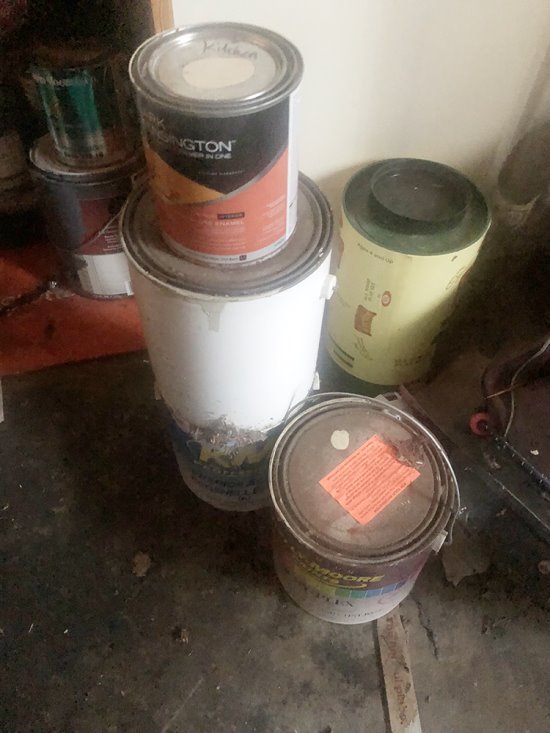 | | | Paint cans often hide in garage back corners for years before a need arises. Photo J. Wake | | | | | | "I have some touch-up paint for that." That sentence lives in infamy recalling the day my client handed me an old paint can. First, the lid was stuck to the can with gobs of hardened paint all over it. I set the can on the cement in the garage and pried the top off, bending it into a misshapen mess in the process.
 The can felt pretty light, certainly not full, and as I mangled the lid, I figured I could save what paint was left after the touch-up task in a smaller jar or can. Lid finally off, I bravely grabbed a stir stick and began to mix the paint as a large chunk of rust broke off the bottom of the can and all the remaining liquid streamed out onto the garage floor. With no top or bottom on the container, all I could do was clean up the mess and tell the client that we would need to paint the entire wall, because the touch-up paint was gone.
The can felt pretty light, certainly not full, and as I mangled the lid, I figured I could save what paint was left after the touch-up task in a smaller jar or can. Lid finally off, I bravely grabbed a stir stick and began to mix the paint as a large chunk of rust broke off the bottom of the can and all the remaining liquid streamed out onto the garage floor. With no top or bottom on the container, all I could do was clean up the mess and tell the client that we would need to paint the entire wall, because the touch-up paint was gone.
 Actually, that is now my standard recommendation to clients, "We should plan to paint the whole wall," (ceiling, room, surface). So let me tell you why.
Actually, that is now my standard recommendation to clients, "We should plan to paint the whole wall," (ceiling, room, surface). So let me tell you why.
 Touch-up paint seldom matches the original color unless the room has recently been painted. There will be a slight color difference where you touch up. Several factors can influence this: Oxidation takes place. The new paint has a fresh clean surface and over time it fades and becomes porous. If the room was painted 10 years ago, the surface of old paint is not the same as it was when it was new. Sunlight will cause the color to fade over time. The fresh paint from the can will be the original color, but that no longer matches the wall.
Touch-up paint seldom matches the original color unless the room has recently been painted. There will be a slight color difference where you touch up. Several factors can influence this: Oxidation takes place. The new paint has a fresh clean surface and over time it fades and becomes porous. If the room was painted 10 years ago, the surface of old paint is not the same as it was when it was new. Sunlight will cause the color to fade over time. The fresh paint from the can will be the original color, but that no longer matches the wall.
 If the reason for touch-up painting is to cover patching to the wall, the patching compound will absorb more of the new paint than the old paint unless it is sealed with a primer first. (Some cans of spackle claim they are "paint ready" and don't need primer; I'm not sure about that.)
If the reason for touch-up painting is to cover patching to the wall, the patching compound will absorb more of the new paint than the old paint unless it is sealed with a primer first. (Some cans of spackle claim they are "paint ready" and don't need primer; I'm not sure about that.)
 Anyway, unless the area being touched up is in a closet or going to be behind furniture or covered by artwork, touch-up painting may not hide the patches. At the very least, be prepared to repaint if the touch-up doesn't meet your expectations.
Anyway, unless the area being touched up is in a closet or going to be behind furniture or covered by artwork, touch-up painting may not hide the patches. At the very least, be prepared to repaint if the touch-up doesn't meet your expectations.
 By the way, new paint cans have a plastic bottom. If the can of touch-up-paint you're holding has a metal bottom, you know it's old. Check for small rust spots too. You may want to put the paint can in an old dishpan or pie pan before you stir it. It might be better to just dispose of that old paint by taking it to a paint disposal recycling place. Empty cans and dried paint can safely go in the trash. There is a product you can buy at the paint sales counter which absorbs paint in the can and dries it up, so you can simply chuck it.
By the way, new paint cans have a plastic bottom. If the can of touch-up-paint you're holding has a metal bottom, you know it's old. Check for small rust spots too. You may want to put the paint can in an old dishpan or pie pan before you stir it. It might be better to just dispose of that old paint by taking it to a paint disposal recycling place. Empty cans and dried paint can safely go in the trash. There is a product you can buy at the paint sales counter which absorbs paint in the can and dries it up, so you can simply chuck it.
 One additional tip: paint color matching technology is excellent these days. If you want to match the color on the wall and don't have the original can, a sample of the color can be matched by a photo-spectrometer at the paint store. You may be able to collect a color sample from debris while doing demolition. If a large enough sample (at least one inch square) is not available, you might carve a sample of the paint with a razor knife from an inconspicuous corner (or behind a door) and then patch that spot along with the wall.
One additional tip: paint color matching technology is excellent these days. If you want to match the color on the wall and don't have the original can, a sample of the color can be matched by a photo-spectrometer at the paint store. You may be able to collect a color sample from debris while doing demolition. If a large enough sample (at least one inch square) is not available, you might carve a sample of the paint with a razor knife from an inconspicuous corner (or behind a door) and then patch that spot along with the wall.
 The paint store will want to know what type of paint you are matching. Be prepared to answer questions about the sheen: Flat/Matte, Eggshell, Semi-Gloss/Satin, or Gloss. Hopefully you get a kindly salesclerk who will help you decide. Occasionally you see a clerk with the attitude, "If you don't know; you don't belong here and I can't help you."
The paint store will want to know what type of paint you are matching. Be prepared to answer questions about the sheen: Flat/Matte, Eggshell, Semi-Gloss/Satin, or Gloss. Hopefully you get a kindly salesclerk who will help you decide. Occasionally you see a clerk with the attitude, "If you don't know; you don't belong here and I can't help you."
 There is no harm in trying to touch up some small spots, however, you may end up repainting a larger area. It may be more work, but just think how pleased you will feel in a clean and freshly painted room.
There is no harm in trying to touch up some small spots, however, you may end up repainting a larger area. It may be more work, but just think how pleased you will feel in a clean and freshly painted room.
 Bottom line: beware of old and rusty paint cans.
Bottom line: beware of old and rusty paint cans. |

